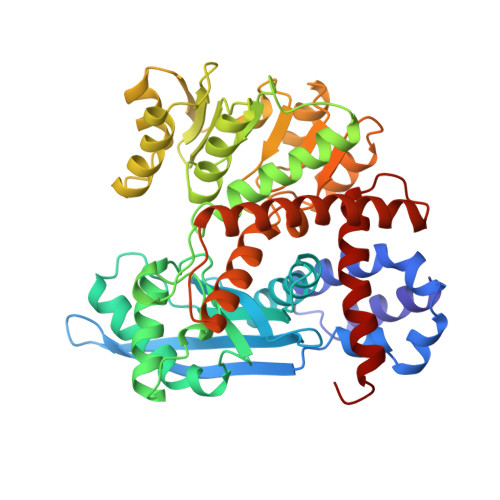Insights into the mechanism of domain closure and substrate specificity of glutamate dehydrogenase from Clostridium symbiosum.
Stillman, T.J., Migueis, A.M., Wang, X.G., Baker, P.J., Britton, K.L., Engel, P.C., Rice, D.W.(1999) J Mol Biol 285: 875-885
- PubMed: 9878450
- DOI: https://doi.org/10.1006/jmbi.1998.2335
- Primary Citation of Related Structures:
1K89 - PubMed Abstract:
Comparisons of the structures of glutamate dehydrogenase (GluDH) and leucine dehydrogenase (LeuDH) have suggested that two substitutions, deep within the amino acid binding pockets of these homologous enzymes, from hydrophilic residues to hydrophobic ones are critical components of their differential substrate specificity. When one of these residues, K89, which hydrogen-bonds to the gamma-carboxyl group of the substrate l-glutamate in GluDH, was altered by site-directed mutagenesis to a leucine residue, the mutant enzyme showed increased substrate activity for methionine and norleucine but negligible activity with either glutamate or leucine. In order to understand the molecular basis of this shift in specificity we have determined the crystal structure of the K89L mutant of GluDH from Clostridium symbiosum. Analysis of the structure suggests that further subtle differences in the binding pocket prevent the mutant from using a branched hydrophobic substrate but permit the straight-chain amino acids to be used as substrates. The three-dimensional crystal structure of the GluDH from C. symbiosum has been previously determined in two distinct forms in the presence and absence of its substrate glutamate. A comparison of these two structures has revealed that the enzyme can adopt different conformations by flexing about the cleft between its two domains, providing a motion which is critical for orienting the partners involved in the hydride transfer reaction. It has previously been proposed that this conformational change is triggered by substrate binding. However, analysis of the K89L mutant shows that it adopts an almost identical conformation with that of the wild-type enzyme in the presence of substrate. Comparison of the mutant structure with both the wild-type open and closed forms has enabled us to separate conformational changes associated with substrate binding and domain motion and suggests that the domain closure may well be a property of the wild-type enzyme even in the absence of substrate.
Organizational Affiliation:
University of Sheffield, Sheffield, Western Bank, S10 2TN, UK.














